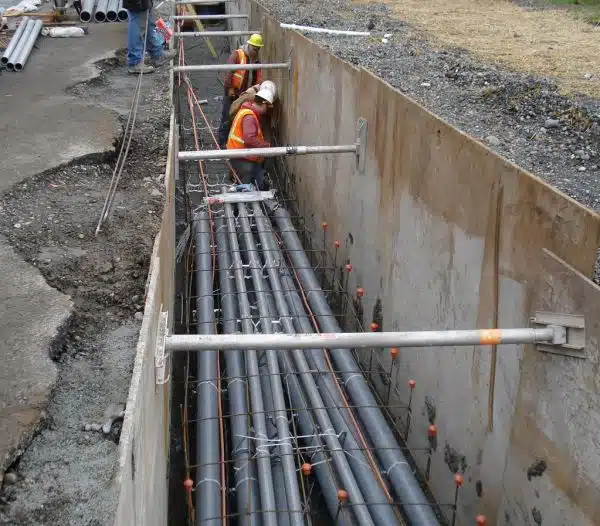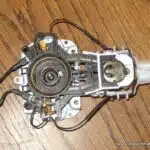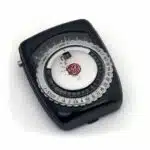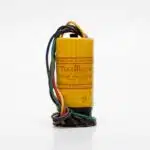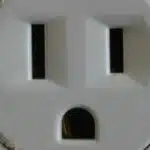As an electrical engineer, it is crucial to ensure that all installations are up to code and meet the necessary safety regulations. One aspect of this is installing underground electric conduit properly, which plays a critical role in protecting electrical wires from damage while also ensuring that they remain accessible for maintenance purposes.
Installing underground electric conduit requires careful planning and execution to avoid potential hazards. This article will outline the steps required for installing underground electric conduit up to code, including selecting the appropriate materials, determining proper depth and spacing, and ensuring that all connections are secure and protected. By following these guidelines, you can ensure that your installation meets all necessary safety standards while also providing reliable and efficient electrical service to your customers.
Understanding The Importance Of Proper Electrical Installation
Imagine a scenario where you have installed an underground electric conduit without following the proper safety protocols. You might think everything is fine until one day, the system malfunctions, causing a power outage or worse, an electrical fire. Such accidents can cause injuries, property damage, and in extreme cases, fatalities. The importance of proper electrical installation cannot be overstated; it ensures that your electrical system is safe and reliable.
The primary goal of any electrical installation is to provide a safe and reliable supply of electricity to homes or commercial buildings. Proper installation involves adhering to local codes and standards that govern every aspect of the project from design to testing. These codes are designed to minimize risks associated with electricity such as electrocution, fires, and short circuits.
Proper electrical installation also guarantees the reliability of your system. A poorly installed system will often experience frequent breakdowns that can be costly both in terms of repairs and lost productivity. With proper installation procedures in place, you can enjoy a reliable supply of electricity without worrying about interruptions or damages caused by faulty wiring or other hazards.
To ensure your underground electric conduit is installed up to code, it’s essential to understand the importance of proper installation for safety and reliability reasons. Adhering to codes not only minimizes risks but also saves you from costly repairs due to frequent breakdowns caused by poor installations. In the subsequent section, we will discuss how selecting the right materials for your project is crucial in ensuring proper installation procedures are followed.
Selecting The Right Materials For Your Project
Understanding the importance of proper electrical installation is crucial for any construction project. One key aspect of this is ensuring that all underground electric conduit installations are up to code. The code requirements for underground electric conduit installation vary depending on location, but generally include guidelines for depth, diameter, and material.
Choosing the appropriate conduit diameter is an important factor in meeting code requirements. The diameter should be large enough to accommodate all necessary wires and cables while still fitting within the designated trench or pathway. In addition, it’s important to consider future expansion needs when selecting conduit diameter. Consult local codes for specific size requirements in your area.
When it comes to material options for underground electric conduit, there are two main choices: PVC and metal. PVC is lightweight, easy to install, and corrosion-resistant. However, metal conduit offers greater durability and can withstand higher temperatures. Again, consult local codes to determine which materials are acceptable in your area.
In order to ensure a successful installation of underground electric conduit up to code, choosing the right materials is crucial. When choosing conduit diameter and material options such as PVC or metal, it’s important to keep in mind not only current needs but also potential future expansion needs. With these factors in mind, you can make informed decisions that will help ensure a safe and reliable electrical system for years to come. Next up we will discuss determining the appropriate depth for your conduit installation without compromising safety standards.
Determining The Appropriate Depth For Your Conduit
When installing underground electric conduit, it is crucial to determine the appropriate depth to ensure that it is up to code and safe for use. This involves measuring the depth of the trench where the conduit will be placed. The depth must be deep enough to protect the conduit from damage caused by external factors such as frost, vehicular traffic, or digging activities.
Measuring depth requires careful consideration of soil type. Different soil types have varying properties that may affect how deeply you need to install your conduit. For instance, if you are working with clay soils, they tend to absorb moisture easily and expand when wet. This can cause damage to your conduit if it is not installed deep enough. On the other hand, sandy soils drain water quickly and do not expand when wet; therefore, your conduit may not need to be installed as deeply.
Soil type considerations should always be taken into account when determining the depth at which your underground electric conduit should be installed. Failure to consider these factors could lead to serious safety hazards down the line. In our next section, we will discuss ensuring proper spacing between conduits for efficient electrical installation.
Ensuring Proper Spacing Between Conduits
Having determined the appropriate depth for your conduit, the next step in ensuring a successful installation is to adhere to the conduit spacing requirements. These requirements are put in place to ensure that there is adequate clearance between conduits, preventing any potential damage that could occur due to overheating or electrical interference. The National Electric Code (NEC) provides specific guidelines for conduit spacing based on the size and type of conduit being used.
When installing conduits, it is important to maintain adequate clearance between them. The NEC specifies that conduits must be spaced at least three times their diameter apart from one another. This ensures that there is enough space for ventilation and heat dissipation, which reduces the risk of overheating and electrical interference. It also helps prevent damage to the conduits themselves, as well as any other nearby electrical components.
In addition to following NEC guidelines for conduit spacing, it is important to choose the right type of conduit for your needs. Different types of conduits are designed with different materials and specifications, making them better suited for certain applications than others. By understanding your specific needs and choosing a suitable conduit material and type, you can ensure that your installation meets all necessary safety standards while also providing reliable power distribution.
Choosing The Right Type Of Conduit For Your Needs
- There are various types of conduit available for use in a variety of applications, including rigid, intermediate metal, electrical metallic tubing (EMT), and flexible.
- The material of the conduit should be chosen according to the environment in which it is to be used, with options including metal, plastic, fiberglass, or even a combination of these.
- When considering sizes, the conduit diameter should be chosen based on the number and size of the cables being run and the type of conduit being used.
- Rigid conduit is usually made of galvanized steel or aluminum, and is available in a variety of sizes from ½” to 6”.
- Electrical Metallic Tubing (EMT) is made of thin-walled galvanized steel and is available in sizes ranging from ¾” to 4”.
- Flexible conduit is available in a variety of materials, including metal, plastic, and liquid-tight, and is available in sizes from ½” to 4”.
Types Of Conduit
When it comes to installing underground electric conduit, choosing the right type of conduit is crucial for ensuring a safe and efficient installation. There are several types of conduit available in the market, each with its own set of advantages and disadvantages. As an electrical engineer, it is important to understand the best applications for each type of conduit and how they can benefit your specific project.
One common type of conduit is PVC (polyvinyl chloride), which is widely used due to its affordability and versatility. PVC conduit is lightweight and easy to install, making it a popular choice for residential installations. However, it may not be suitable for more heavy-duty applications as it has lower impact resistance than other types of conduit.
Another option is rigid metal conduit (RMC), which provides superior protection against physical damage and electromagnetic interference. RMC is ideal for commercial or industrial installations where durability and reliability are critical factors. However, it can be more expensive than other types of conduit and requires specialized tools for installation.
Lastly, flexible metal conduit (FMC) offers the flexibility needed to navigate through tight spaces without compromising protection. FMC is commonly used in areas where vibration or movement may occur, such as in machinery or equipment rooms. On the downside, FMC can be more difficult to install compared to other types of conduit.
In conclusion, choosing the right type of underground electric conduit depends on various factors such as budget, application requirements, and local building codes. As an electrical engineer serving others, it’s essential to weigh the advantages and disadvantages of each option before making a decision that ensures a safe and efficient installation that meets code standards.
Conduit Material
When it comes to installing underground electric conduit, one crucial factor to consider is the material of the conduit. The durability and cost-effectiveness of a conduit material are significant factors in deciding which material to use for your project. As an electrical engineer, it is essential to understand the pros and cons of each material and how they can impact the installation.
One common type of conduit material is PVC (polyvinyl chloride), which provides cost-effectiveness and versatility. PVC conduit is lightweight, easy to install, and has excellent chemical resistance, making it a suitable choice for residential installations. However, it may not be as durable as other materials when exposed to extreme temperatures or physical damage.
Another option is metal conduit, which offers superior durability compared to PVC. Rigid metal conduit (RMC) provides excellent protection against physical damage and electromagnetic interference, making it ideal for commercial or industrial installations. Although more expensive than PVC, RMC’s longevity makes it cost-effective in the long run.
Lastly, flexible metal conduit (FMC) offers both flexibility and durability for installations that require movement or vibration resistance. While FMC is reasonably priced compared to RMC, it can be more challenging to install due to its flexibility. Therefore, careful consideration must be taken when choosing FMC for your project.
In conclusion, choosing the right type of underground electric conduit requires careful consideration of several factors such as budget, application requirements, local building codes, and most importantly: Conduit durability and Conduit cost-effectiveness. As an electrical engineer serving others in the best way possible, understanding each material’s advantages and disadvantages will ensure a safe and efficient installation that meets code standards while also being budget-friendly for your client or organization’s needs.
Conduit Sizes
After considering the material of the conduit, another crucial factor to think about is the conduit diameter. Choosing the right diameter for your project can affect its functionality and cost-effectiveness. As an electrical engineer, it is essential to understand how different conduit diameters can impact the installation.
One key consideration when selecting a conduit size is the number and type of wires that will run through it. For projects that require a large number of wires or thicker cables, a larger diameter conduit may be necessary to accommodate them adequately. On the other hand, smaller projects with fewer wires may only require a smaller diameter conduit.
Another important factor to consider when choosing a conduit size is potential future expansion or modification needs. It’s best to plan ahead and choose a larger diameter conduit if there’s even a possibility that more wires or cables may need to be added in the future. This can save time and money by avoiding the need for costly re-installations later on.
In summary, selecting the right size of underground electric conduit depends on several factors such as wire count/type, potential future modifications, and local building codes. As an electrical engineer dedicated to serving others’ needs, it’s essential to weigh these factors carefully to ensure efficient installation while keeping costs within budget constraints. By understanding each material’s advantages and disadvantages and considering appropriate sizing requirements, you can provide safe, reliable electrical installations that meet code standards and exceed your clients’ expectations.
Digging The Trench For Your Conduit
The successful installation of underground electric conduit largely depends on the proper trenching techniques. A trench dug for electrical conduit must be deep enough to meet code requirements and avoid damage from external factors such as frost heaves, tree roots, and other environmental factors. When digging the trench, it is important to minimize environmental impact by avoiding areas with sensitive vegetation or wildlife habitats.
To ensure a safe and effective installation of your electrical conduit, consider the following tips:
- When digging your trench, make sure it is at least 18 inches deep to avoid damage from frost heaves or other environmental factors.
- Avoid using heavy equipment that can cause soil compaction or other damage to the surrounding environment.
- Use caution when digging near trees or other sensitive vegetation to avoid damaging their root systems.
- Consider carefully where you will deposit excess soil from your trench to minimize its impact on nearby ecosystems.
Using these techniques will help you create a safe and environmentally responsible trench for your underground electric conduit. By taking care during this step of the installation process, you can ensure a successful project that meets all relevant codes and regulations.
As you move on to laying and securing your conduit in the trench, remember that careful attention to detail is key. With proper planning and execution, your underground electric conduit will provide reliable power for years to come.
Laying And Securing Your Conduit In The Trench
Ah, the joys of laying and securing your conduit in the trench. It’s almost as exciting as watching paint dry or grass grow. But fear not, for this is an essential step in ensuring your underground electric conduit is up to code. Let’s dive into the depths of trench depth and conduit placement.
Firstly, let’s talk about trench depth. The depth of your trench will depend on a few factors such as local building codes and the type of conduit you’re using. As a rule of thumb, most conduits should be buried at least 18 inches below ground level to protect them from damage caused by weather or other external factors. However, some local codes may require deeper trenches so it’s important to check before proceeding.
Next up, we have conduit placement. When placing your conduit in the trench, make sure it’s positioned directly in the center and that there are no sharp bends or angles. This will help prevent any damage to the wires inside and ensure proper installation. Additionally, make sure there is enough space between each piece of conduit to allow for expansion and contraction due to changes in temperature.
Now that we’ve covered trench depth and conduit placement, it’s time to move onto making sure your conduit is level. This step is crucial to ensure proper installation and avoid any future problems with electrical performance. So grab your level and get ready for the next section where we’ll show you how to make sure your conduit stays put!
Making Sure Your Conduit Is Level
After laying and securing your conduit in the trench, the next step is to make sure that it is level. This is important because any deviation from level can cause water to collect in the conduit and affect its long-term durability. Leveling techniques involve using a bubble level or laser level to ensure that the conduit is completely flat along its length.
Equipment requirements for leveling your conduit include a bubble level or laser level, a measuring tape, and stakes to mark out the trench. The bubble level is an inexpensive tool that can be used for small projects, while a laser level may be more appropriate for larger projects where precision is critical. Stakes are used to mark out the trench so that you know where to begin and end your leveling process.
Proper leveling of your underground electric conduit is essential for ensuring its longevity and safety. By using the right equipment and techniques, you can achieve a perfectly flat surface that will provide reliable service for years to come. The next step in this process involves installing conduit bends and fittings, which we will cover in detail in the following section.
Installing Conduit Bends And Fittings
As the saying goes, “Measure twice, cut once.” This phrase applies perfectly to conduit installation techniques. Before installing conduit bends and fittings, make sure to accurately measure the length of the conduit required for your project. Once you have the measurements, it’s time to start cutting and fitting.
When it comes to fitting the conduit, there are some common mistakes that must be avoided. One of these mistakes is using too much force when inserting the conduits into a fitting. Doing so can cause damage to both the conduit and fitting, leading to future problems down the line. Another common mistake is not deburring or smoothing out any rough edges on the inside of the conduit before installing it into a fitting. This can lead to wire abrasion over time.
To ensure a successful installation, consider following these nested bullet point lists:
- Tools Required:
- Measuring tape
- Hacksaw
- Deburring tool
- Steps for Smooth Installation:
- Measure and mark where you need to make cuts on your conduit.
- Cut your conduit with a hacksaw.
- Smoothen out any rough edges with a deburring tool.
- Fit your conduits into each other using appropriate fittings.
By following these tips and avoiding common mistakes during the installation process, you can ensure that your underground electric conduit is up to code and will serve its purpose for years to come. However, securing your conduit to prevent movement is just as important as proper installation techniques. In the next section, we will discuss how to secure your conduit in place once it has been installed properly.
Securing Your Conduit To Prevent Movement
Preventing movement of your conduit is a crucial aspect of installing underground electric conduit up to code. Movement can cause damage to the wires or create disconnections, leading to power outages and other hazards. Therefore, anchoring techniques are necessary to secure your conduit in place.
One common technique for anchoring your conduit is using concrete encasement. This involves pouring concrete around the conduit to hold it in place. The concrete should be at least 2 inches thick and extend for at least 6 inches on either side of the conduit. This will provide a solid base and prevent any lateral movement of the conduit.
Another technique is using trench blocks or bricks as supports for the conduit. These blocks should be placed at regular intervals along the length of the trench and spaced no more than 4 feet apart. The conduit should then be secured to these blocks using clamps or straps. This method provides stability and prevents vertical movement of the conduit.
In conclusion, preventing movement of your underground electric conduit is essential for proper installation up to code. Anchoring techniques such as concrete encasement and trench block supports can help ensure that your conduit stays in place and prevents any damage or hazards. In the next section, we will discuss connecting your wires to the conduit, which is another critical step in completing this project successfully.
Connecting Your Wires To The Conduit
How can you ensure that your wiring is properly connected to the conduit? Wiring techniques play a crucial role in making sure that your electrical system runs smoothly. One technique is to strip the wire back 1/2 inch and use a crimp connector to attach it to the conduit. Another technique involves wrapping the wire around a screw terminal and tightening it securely.
Conduit junctions are also an important consideration when connecting your wires. Make sure that all junctions are properly secured and sealed with weather-tight connectors. These connectors help protect against moisture and other elements that could compromise the integrity of your electrical system.
In addition, it’s important to protect your connections from moisture and corrosion. This can be achieved by using heat shrink tubing or electrical tape to wrap around exposed connections. By taking these steps, you can ensure that your electrical system is up to code and safe for use. Next, we will discuss how to protect your connections from moisture and corrosion for optimal performance.
Protecting Your Connections From Moisture And Corrosion
- Underground electrical conduits must be moisture-proofed in order to protect them from the elements.
- Corrosive materials, such as salts, acids, and alkalis, must be prevented from entering the conduit system, in order to avoid corrosion of the electrical connections.
- It is important to install underground electrical conduits up to code, as improper installation can lead to dangerous situations.
- To protect connections from moisture and corrosion, it is advisable to use materials such as PVC, galvanized steel, and other corrosion-resistant metals.
Moisture-Proofing
To ensure that your underground electric conduit installation is up to code, moisture-proofing is a crucial step. Moisture can lead to corrosion and electrical shorts, which can be hazardous and costly. Therefore, it is important to use waterproofing methods and conduit sealing techniques to protect your connections from moisture and corrosion.
One effective way to moisture-proof your underground electric conduit is by using waterproof sealants. These sealants are designed to prevent water from penetrating the conduit and causing damage. Additionally, you can use heat shrink tubing or tape to further seal the connections between the conduit and wiring. It’s important to choose sealants that are specifically designed for electrical applications, as some materials may degrade over time when exposed to electrical currents.
Another method for moisture-proofing your underground electric conduit is by installing a drainage system around it. This involves digging a trench around the conduit and filling it with gravel or other porous material that allows water to drain away from the conduit. Additionally, you can install a sump pump or other drainage mechanism if necessary. By preventing water from accumulating around the conduit, you can reduce the risk of corrosion and electrical shorts.
In summary, protecting your connections from moisture and corrosion is essential for ensuring safe and reliable operation of your underground electric conduit. Waterproofing methods such as sealants and drainage systems can help prevent water from penetrating the conduit and causing damage. By taking these precautions, you’ll be able to enjoy worry-free electricity for years to come.
Corrosion Protection
To ensure the longevity and reliability of your underground electric conduit, preventing corrosion is crucial. Corrosion can cause damage to the conduit and its connections, which can result in safety hazards and costly repairs. Therefore, it’s important to take measures to prevent corrosion from occurring.
One way to prevent corrosion is by using corrosion-resistant materials in your conduit installation. These materials are designed to withstand exposure to moisture, chemicals, and other corrosive elements, reducing the risk of damage over time. Additionally, coatings or treatments can be applied to protect the surface of the conduit from corroding agents.
Another method for preventing corrosion is by implementing proper grounding techniques. Grounding provides a path for electrical currents that may escape from the wiring or connections, which can reduce the likelihood of corrosion occurring. Proper grounding also helps to protect against electrical surges and other types of damage caused by lightning strikes or power outages.
In summary, preventing corrosion is essential for ensuring that your underground electric conduit operates safely and reliably over time. By using corrosion-resistant materials, applying protective coatings or treatments, and implementing proper grounding techniques, you can help to reduce the risk of damage caused by corrosive agents. With these precautions in place, you’ll be able to enjoy uninterrupted electricity without worrying about safety hazards or costly repairs.
Covering And Backfilling Your Trench
Once you have laid your underground electric conduit, it is essential to cover and backfill the trench properly. Proper compaction is crucial to ensure that the earth settles evenly and does not cause any deformation or damage to the conduit. The backfill material should be free of rocks, debris, and vegetation that can cause punctures or other damage to the conduit.
Drainage considerations are also an important factor when covering and backfilling your trench. Good drainage helps prevent water accumulation around the conduit, which can cause corrosion or other damage over time. The backfill material should be free-draining and non-porous to allow water to flow away from the conduit.
To ensure proper compaction and drainage, consider using a compactor machine for larger trenches. For smaller trenches, hand tamping with a heavy-duty tamper may be sufficient. Additionally, consider adding a layer of sand or gravel around the conduit before adding the final layer of soil to aid in drainage.
Next, testing your installation for safety and efficiency is critical before turning on any electrical power sources.
Testing Your Installation For Safety And Efficiency
Testing voltage is an important part of ensuring an underground electric conduit up to code. To ensure safety, the voltage should be tested to make sure the voltage of the wiring is within the specified standards. Measuring amperage is another important step in the installation process. It is necessary to know the amperage to ensure the underground conduit is not overloaded and is operating at its most efficient capacity.
Testing Voltage
As an electrical engineer, it is important to ensure that your underground electric conduit installation is safe and efficient. One way to do this is by testing the voltage of the system. Testing voltage involves measuring resistance and troubleshooting voltage drops.
Measuring resistance can help identify any potential issues in the installation. This can be done by using a multimeter to measure the resistance between different points in the system. If there is a high resistance reading, this could indicate a problem such as a damaged wire or a loose connection.
Troubleshooting voltage drops involves identifying where the voltage drop is occurring and finding ways to fix it. Voltage drops can occur when there is too much current flowing through a wire or when there are too many devices connected to a single circuit. By identifying where the voltage drop is occurring, you can determine what needs to be done to fix it and ensure that your underground electric conduit installation is working efficiently.
By testing the voltage of your underground electric conduit installation, you can ensure that it is safe and efficient for use. Measuring resistance and troubleshooting voltage drops are two important steps in this process that should not be overlooked. As an electrical engineer, it is your responsibility to provide reliable and safe electrical solutions for those who will benefit from them.
Measuring Amperage
As an electrical engineer, ensuring the safety and efficiency of underground electric conduit installations is a top priority. Testing the voltage of the system is one way to achieve this. However, measuring amperage is also crucial in identifying potential issues that could compromise safety.
Measuring amperage involves determining the amount of current flowing through a wire or circuit. This can be done using an ammeter, which measures the amount of amps passing through a point in the system. It is important to take safety precautions when measuring amperage, such as wearing protective gear and ensuring that all equipment is properly grounded.
To measure amperage, you will need an ammeter and a clamp to attach it to the wire or circuit being tested. It is recommended to test each wire or circuit individually to ensure accurate readings. Measuring amperage can help identify overloaded circuits, faulty wiring, and other potential hazards that could compromise the safety and efficiency of the installation.
In conclusion, measuring amperage is an essential step in testing your underground electric conduit installation for safety and efficiency. By taking proper safety precautions and using the necessary equipment, you can accurately measure amperage and identify any potential issues that need to be addressed. As electrical engineers, it is our responsibility to prioritize safety in all our installations.
Ensuring Your Installation Meets Local And National Codes
After testing your installation for safety and efficiency, it is important to ensure that it meets local and national codes. Failure to comply with these codes may result in safety hazards and legal consequences. As an electrical engineer, it is your responsibility to guarantee that your installation is up to code.
Common code violations include improper grounding, insufficient conduit size, and inadequate support of the conduit. These violations can lead to electrical shock, fires, or damage to the wiring system. To avoid these issues, you should refer to the National Electrical Code (NEC) and consult with local authorities for specific requirements.
To help ensure that your installation meets local and national codes, use an inspection checklist. This checklist should include items such as proper grounding techniques, correct conduit size and material specifications, appropriate support for the conduit, and verification of proper wire sizing. By using a comprehensive inspection checklist, you can verify that each element of the installation complies with applicable codes.
| Item | Requirement | Verification |
|---|---|---|
| Grounding | Properly grounded with grounding rod | Check grounding rod placement |
| Conduit Size | Adequate size for wires being used | Measure diameter of conduit |
| Conduit Material | Appropriate material for intended use | Confirm material specification |
| Support | Adequate support at regular intervals | Inspect hanger spacing |
| Wire Sizing | Correct gauge for voltage and amperage requirements | Verify wire gauge |
By following these guidelines and using an inspection checklist during your installation process, you can prevent common code violations and ensure a safe electrical system. Remember to always reference the NEC and consult with local authorities when necessary. As an electrical engineer, it is crucial that you prioritize safety in all aspects of your work.
Conclusion
In conclusion, it is essential to understand the importance of proper electrical installation when installing underground electric conduit up to code. Choosing the right materials for your project, determining the appropriate depth for your conduit, ensuring proper spacing between conduits, and selecting the right type of conduit for your needs are all critical factors in achieving a safe and efficient installation. Protecting your connections from moisture and corrosion, covering and backfilling your trench, testing your installation for safety and efficiency, and ensuring that it meets local and national codes are equally important.
As an electrical engineer, it is imperative to adhere to standards set by regulatory bodies such as the National Electrical Code (NEC) when installing underground electric conduits. This includes proper grounding of equipment, meeting spacing requirements between conductors, using appropriate materials for insulation and protection against physical damage, among others. Failure to comply with these regulations can lead to hazardous situations that may compromise the safety of individuals or property. Therefore, always ensure that you follow best practices when installing underground electrical conduit to avoid unpleasant outcomes down the line.
Image Credits
- “Electrical Line Relocation Project – Installing conduit” by WSDOT (featured)

